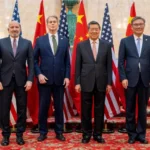Global economic momentum is fading fast — and the World Bank is sounding the alarm.
In its Global Economic Prospects report released Tuesday, the Bank cut its 2025 global growth forecast to 2.3%, down 0.4 points from January. Even more concerning, it warned that if current trends continue, average growth for the first seven years of the 2020s will be the weakest of any decade since the 1960s.
“The sharp increase in tariffs and ensuing uncertainty are contributing to a broad-based growth slowdown,” the report said.
The warning comes after President Trump’s sweeping 10% tariff on all US imports, plus increased duties on steel and aluminum, which have roiled markets and dampened global confidence. Nearly two-thirds of all countries saw growth forecasts revised down, including major economies like the US, Japan, and the EU.
US Downgraded – China Holds Steady
The US growth outlook was cut for both 2025 and 2026, with the Bank citing eroding investor confidence and weakening consumer demand under trade pressure.
However, China — despite being at the heart of the US trade conflict — avoided a downgrade. The World Bank credited Beijing’s “financial buffers” and relative resilience amid global headwinds.
Tariffs, Inflation, and Debt Clouds Ahead
- The Bank warned that global trade could seize up in H2 2025 if tariff escalations continue.
- Inflation is expected to remain elevated at 2.9% globally, above pre-pandemic norms.
- Developing countries are under added pressure: growth is forecast at just 3.8% in 2025, over 1% below their 2010s average.
- Debt is surging, while investment and trade are both slowing sharply.
“Emerging markets reaped rewards of trade integration but now find themselves on the frontlines of a global trade conflict,” said World Bank’s M. Ayhan Kose.
Can Growth Be Saved?
The World Bank outlined one way out: halve current tariffs through new trade agreements and the world could claw back 0.2 percentage points of growth annually in 2025–2026.
But that would require Trump to walk back trade barriers — something he has shown no appetite for.
Meanwhile, the OECD echoed the gloom, cutting its own global forecast to 2.9%, warning the tariff fallout is “worse than we previously thought.”
Markets may be calm for now, but the underlying message from both World Bank and OECD is clear: the global economy is dragging, not drifting. Tariffs are the storm cloud, and Trump’s aggressive trade playbook is shaking the confidence of companies, investors, and policymakers alike.
Unless trade talks (like this week’s in London) deliver real progress, another leg down in sentiment may be just around the corner.
The full report: https://www.worldbank.org/gep
Disclosure: This article does not represent investment advice. The content and materials featured on this page are for educational purposes only.
Related:
US-China Trade Talks Enter Pivotal Day Two in London
Washington Starts to ‘De-Musk’: 5 Stocks Poised to Gain From the Shift
Trump says relationship with Musk is over and threatens him
Elon Musk Empire Under Fire: What Trump’s Revenge Could Mean for Tesla and SpaceX
“You Mean Man Who Lost His Mind?” — Trump Slams Door on Musk
Timeline of Elon Musk and Donald Trump “Break Up”
Why Trump Can’t Just Quit Elon Musk — Even After Their Public Breakup










